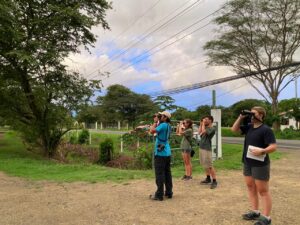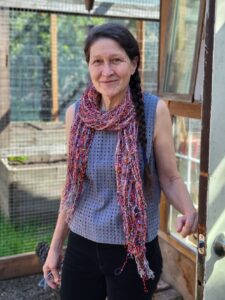
INTRODUCING THE NETWORK
An easy way to think about what Jose Antonio Diaz Luque wants to bring to the Macaw Recovery Network as its first Network Program Coordinator is to imagine sitting in a dark room, trying to read by candlelight. Someone walks in and hands you a flashlight. You now can scroll across the pages of your book, sentence by sentence.
Jose walks in, finds a light switch and turns it on. Now you can read effortlessly, plus you notice others in the room. They are reading, too, and soon everyone is sharing their ideas, swapping books, and learning from each other.

Though “Network” is part of the MRN name, Jose says, the work of “Macaw Recovery” has required the organization’s fulltime attention to its Macaw wild and captive breeding and reintroduction program, habit protection and restoration, and community outreach. Now that these programs are up and running, he says, MRN can concentrate on building the “Network.”
In October 2021, Jose came on board to head the new Network Program to link individuals and conservation groups among several countries where endangered parrots live. Through the program, a “mastermind group” of seven conservationists from Bolivia, Colombia, Costa Rica, Nicaragua, Panama and Mexico are swapping ideas and coordinating their efforts to save Scarlets Macaws, Blue-Throated Macaws, Red- Fronted Macaws, Great Green Macaws and Yellow-naped Parrots.
“All those people are meeting every few months, and we are facilitating those meetings for them to share their activities … and to learn from each other about how to ensure the best success from their actions,” he says. “Everything we are trying to do – either supporting an organization or supporting conservationists – is because we want to ensure the success of species conservation.”

Meanwhile, MRN is working on a five-year plan for its breeding, habitat, and outreach programs in its efforts to save Scarlet Macaws, Great Green Macaws and Yellow-naped Parrots. As part of that process, MRN is networking with others in the Americas involved with these same species to learn what’s worked for them and to share what’s worked for MRN.
Jose predicts that by the end of next year, MRN will see a strong network of individuals and organizations working together for the successful conservation of critically endangered species. He sees MRN at the center of this network, linking the know-how, technical support, and financial resources for the end goal. Less duplication of efforts and fewer agendas going in different directions. Less competition for the same resources and public support.
AN INTERVIEW WITH JOSE
You are organizing the work of the network program around three groups: the species, the organizations working with them, and the individual conservationists. Can you say a bit about each one?

Species like the Great Green Macaw, Yellow-naped Parrots currently have action plans, which take enormous work by different professionals and stakeholders to develop, as a critical tool to structure the conservation priorities for the species. The problem comes during the execution of the plan, where historically there is not good follow and support to guarantee the right execution of the plan. So we, as MRN, we can see ourselves not just supporting the development of new versions of those action plans, but also the needed support during the execution of the action plans.
We also care about institutions because we know as conservationists that the rate of collaboration in conservation can be increased massively. Unfortunately, there are a lot of personal agendas, where organizations perceive competition for funding by everybody looking the same place to obtain resources and not exploring different areas. As a network, we believe that we have the capacity to connect and support different organizations … act as a link between organizations who aims to work together to achieve biggest conservation goals.
Most (conservationists) don’t receive the money they should receive for the work they do, for the amount of hours they work, for the risks they take. But they are really critical for species conservation. We need to take care of our conservationists. We need to (ensure) those people are … fully supported to be able to continue to do what they like to do, which is saving endangered species.
Q: When you talk about a network or networking, you describe it as critical to saving an endangered species. Can you elaborate?

“I love the work we are doing and the scale that we are getting (by networking) … to support conservation outside the Costa Rican borders.
It’s very important to look at the birds in Costa Rica, but it’s also important to ensure the conservation of some of those populations, at least the most endangered ones, by supporting … the work that other organizations are doing in those countries to save those endangered populations.
If we don’t do that, we could be creating in your mind the false idea that we are saving the species. But in reality, what we are doing is just saving the Costa Rican populations.”
A LIFELONG FASCINATION WITH PARROTS

Jose has been fascinated with parrots since one of his many visits as a boy to a pet shop in his hometown in Spain.
“I remember a parrot was being sold in one shop. It was actually a Yellow Crowned Amazon. And I was like ‘I want this parrot. It’s talking, and that’s crazy! How can an animal talk?’”
But he couldn’t afford the bird and his parents wouldn’t buy it for him.
“So, I became crazy about studying parrots, reading absolutely everything on the internet, buying books, going to forums, conferences in Spain just to meet people who know about parrots. I was able to, I am still able to recognize over 300 species of parrots by their scientific names.”
Now 34, with a degree in environmental science, Jose has 15 years of wildlife conservation field work and management, mostly in the tropics with parrots in Bolivia. He’s lived in jungles and risked his welfare working around illegal drug trade operations. He’s protected nests, saved chicks, planted trees, and taught and trained others living in the local communities.

13 years ago, He worked with Dr. Sam Williams with Yellow-Shouldered Amazons in Bonaire, where started a long-term work relation of both in parrot conservation. He’s worked also with Scarlet Macaws and Great Green Macaws in Costa Rica, Honduras and Nicaragua, Giant Anteaters in Argentina, Mariana Crows in the Northern Mariana Islands and Blue Throated Macaws, Red Fronted Macaws and Hyacinth Macaws, the biggest parrot in the world, in Bolivia.
Besides his job with MRN, he is supporting the development of conservation plans for endangered species worldwide as a member of the IUCN SSC Conservation Planning Specialist Group, among them pangolins in South Asia and Africa, frogs in Latin America, beavers in Scotland, parrots in Venezuela, leatherback turtles in the Pacific and cactus in Chile.
“As a person, as a professional, I want to have a massive impact on species conservation,” Jose says, adding that the more “difficult” the work the better. “That’s something I absolutely love. It makes my work be like a rock ’n’ roll concert every single day!”
-Jose Antonio Diaz Luque, MRN Network Program Coordinator
This article was written by Peggy Harris, a friend of Macaw Recovery Network who volunteers her writing talents for conservation.

Peggy Harris
Volunteer Writer